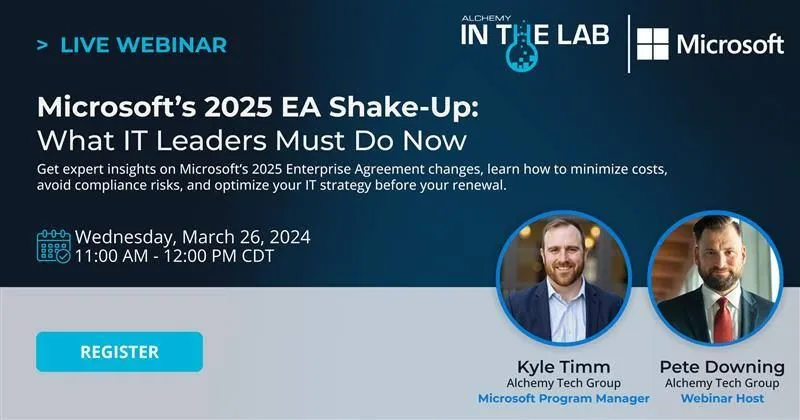Microsoft’s 2025 Enterprise Agreement Changes: What IT Leaders Need to Know Now

Summary
Microsoft is shaking up its Enterprise Agreement (EA) model in 2025. If your organization relies on Microsoft cloud or on-prem services, these changes will impact your licensing strategy, budgeting process, and long-term IT roadmap.
In this Alchemy In the Lab webinar, Alchemy Technology Group’s Pete Downing, a seasoned professional in the field, was joined by Microsoft licensing expert Kyle Timm, who brings over 15 years of Microsoft experience. Together, they provided a deep dive into the changes ahead, helping attendees cut through the noise and understand what’s changing and what it means for enterprise IT teams.
Here’s a breakdown of what we covered—and why it matters.
The EA as You Know It Is Going Away
Microsoft is phasing out the traditional Enterprise Agreement for many organizations, especially those with cloud-only environments. Instead, they are moving customers toward the Microsoft Customer Agreement for Enterprise (MCA-E) or Cloud Solution Provider (CSP) models. The shift is part of a larger push toward a more streamlined, subscription-first licensing framework.
Key changes include:
- Retirement of Software Assurance for new EA enrollments
- Elimination of annual true-ups, which historically allowed for easier compliance management
- A new billing structure based on subscription term length rather than volume discounts
- A centralized product and pricing catalog across all purchasing options
These changes aren’t just administrative—they will significantly impact how your organization provisions Microsoft licenses, manages renewals, and controls IT spending. Understanding these changes is crucial for staying ahead in the evolving IT landscape.
EA vs MCA-E vs CSP: What’s the Difference?
One of the most valuable parts of the session was Kyle’s clear breakdown of the three paths forward: MCA-E, CSP, and self-service. Each path carries different implications for support, flexibility, and cost.
- MCA-E offers a Microsoft-led relationship similar to the traditional EA but with updated terms
- CSP allows for a more partner-led, flexible approach with options for both cloud and perpetual licensing
- Self-service is ideal for smaller teams managing simpler Microsoft needs directly through the portal
Understanding the right path for your organization depends on factors like renewal timelines, existing Microsoft relationships, infrastructure complexity, and whether you’re operating in a commercial or public sector environment.
What Should IT Leaders Do Now?
Whether your EA renews next quarter or next year, preparation starts now. Here are the actions Kyle recommends:
- Evaluate your current licensing position and map what is at risk with the EA retirement
- Identify shelfware and overprovisioned services that are inflating your spend
- Align your licensing strategy with business outcomes, not just budget
- Understand your renewal window so you don’t lose leverage when negotiating
- Engage a trusted Microsoft partner to guide your transition and ensure full ROI
Alchemy’s Microsoft Licensing Mastermind: Free, Focused, and Actionable
To help enterprise IT teams plan, Alchemy is offering a complimentary Microsoft Licensing Strategy Mastermind Engagement. This one-on-one working session with Microsoft licensing experts provides clarity around your options and a roadmap tailored to your organization.
This is the next step if you’re unsure how MCA-E, CSP, or true-up elimination will affect you.
Author